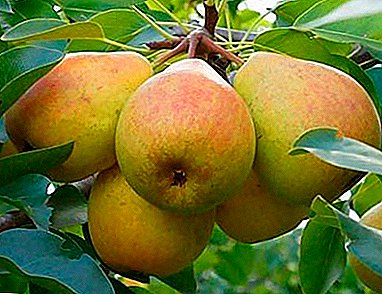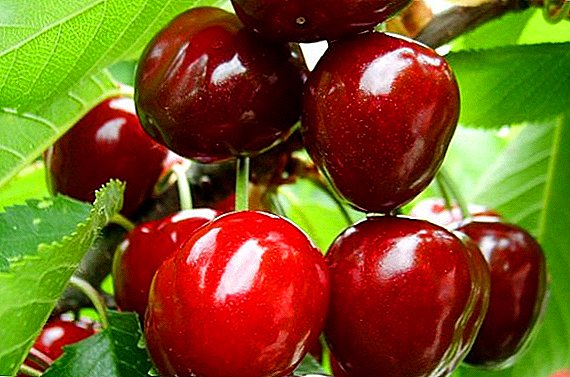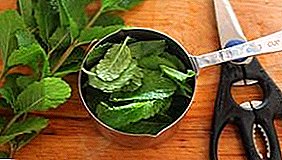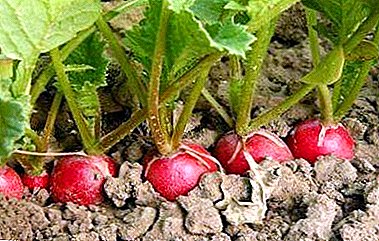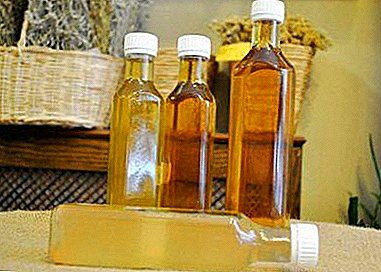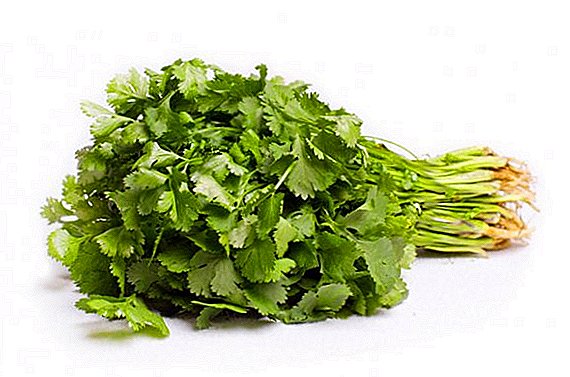 Coriander, or cilantro - a spice that some people almost idolize, while others can not stand, in the truest sense of the word. The reason for this is the characteristic, incomparable, smell of the plant. However, in addition to flavor, cilantro has a lot of other, no less interesting and much more useful qualities.
Coriander, or cilantro - a spice that some people almost idolize, while others can not stand, in the truest sense of the word. The reason for this is the characteristic, incomparable, smell of the plant. However, in addition to flavor, cilantro has a lot of other, no less interesting and much more useful qualities.
Nutritional value and calorie
The nutritional value of the plant (per 100 g) is as follows:
- proteins - 2.08 g;
- fats - 0.48 g;
- carbohydrates - 0.95 g;
- fiber - 2.75 g;
- water - 91.8 g
Caloric content of the plant is only 22 kcal / 100 g. 
Chemical composition
The composition of coriander has a wide range of vitamins and minerals, so that the plant has a lot of useful properties.
Vitamins are presented as follows (per 100 g):
- A - 340 µg;
- B1 - 0.065 mg;
- B2 - 0.159 mg;
- B4 - 13 mg;
- B5 - 0.6 mg;
- B6 - 0.15 mg;
- B9 - 58 µg;
- PP - 1.095 mg;
- C - 28.05 mg;
- E — 2.48 mg;
- K - 307 mcg.
Among the minerals worth highlighting:
- potassium - 518 mg;
- calcium - 68 mg;
- magnesium - 25 mg;
- sodium 47 mg;
- phosphorus - 47 mg;
- iron 1.8 mg;
- manganese - 0.43 mg;
- copper - 230 mcg;
- selenium - 1 µg;
- Zinc - 0.48 mg.
Did you know? Cilantro came to the Russian Empire in the first half of the 19th century, thanks to a secret adviser, Major General PI Apraksin, who brought coriander and anise seeds from Spain, and then instructed the peasants to grow strange overseas vegetation in their gardens.
How is cilantro useful for women?
Cilantro greens, as well as coriander seeds, in the absence of contraindications and moderate use, are useful to absolutely everyone. 
But in certain situations, the plant is of particular interest to women, due to the peculiarities of their body:
- decoction and infusion of green cilantro help relieve pain, often accompanying menstruation, and also help with menopause, PMS, help normalize the menstrual cycle;
- prevents the development of inflammation;
- helps reduce cholesterol and blood glucose levels;
- has a mild natural sedative effect, relieves anxiety, tension of the nervous system, helps to restore sleep;
- It has a bactericidal effect, which is especially effective for inflammations or micranas in the oral cavity;
- due to the high content of vitamin C, cilantro strengthens the immune system, helps with colds, ARVI;
- has mild laxative and diuretic effects;
- due to the high concentration of iron, is an excellent tool for anemia;
- eye treatment with cilantro decoction helps with some problems of the organs of vision;
- normalizes the digestive system, including the digestive tract, liver and kidneys, helps get rid of heartburn;
- due to its bactericidal properties, coriander extract can suppress the development of fungal diseases and inflammation of the skin;
- Coriander seeds help stop the effects of poisoning, including ethyl alcohol.
Important! Coriander oil is a source of citral, a substance used to treat glaucoma and conjunctivitis. This aldehyde is also used to reduce intracranial pressure and the production of vitamin A.
Is it possible to use
Of course, the richest vitamin composition of coriander, as well as the presence of certain minerals, gives every reason to consider culture as a real natural pharmacy. However, despite all the beneficial properties of the plant, in some cases, its use is better to limit or at least consult with a specialist before introducing grass into the diet. 
During pregnancy
During pregnancy, expectant mothers can and should eat cilantro if there are no specific contraindications, which will be discussed below.
Find out what ginger, plum, viburnum and persimmon are good for women.
As part of coriander, there are substances that are especially useful or even indispensable for both the fetus and the expectant mother:
- Vitamin A. It is called the vitamin of vision, among other things, it participates in the mechanism of proper development and cell formation. Vitamin has a remarkable quality: its excessive use has absolutely no negative effects, it is not dangerous for either mother or the unborn child. 100 g of coriander contains about 4 mg of vitamin A, the daily rate for women in the situation is 1 mg.
- Vitamin C. Ascorbic acid is the strongest antioxidant, which reduces the effects of most toxic substances (which is especially important in early pregnancy, with toxicosis), has a strengthening effect on the immune and cardiovascular systems. In addition, vitamin C has a beneficial effect on the condition of the placental vessels, which, in turn, has a positive effect on the supply of oxygen and nutrition to the fetus.
- Vitamin B9. The most important element for the normal development of the fetus and, above all, its neural tube - the basis of the future CNS - is folic acid. A lack of vitamin B9 can lead to abnormal fetal development and even premature early labor. 100 g of green coriander contains 58 µg of folic acid, despite the fact that a woman during pregnancy requires 200-280 mg of this vitamin.
- Vitamin K. Phylloquinone, or vitamin K, plays a huge role in the mechanism of blood coagulation. This substance is sometimes given to women in labor with the threat of generic complications and heavy bleeding. In addition, the vitamin has bactericidal properties, analgesic effect, is involved in protein synthesis. The content of vitamin K in kinza is over 300 mcg per 100 g, and only 50 g of green is enough to meet the daily need for vitamin during pregnancy (137 mcg).
- Potassium. This macro element is involved in almost all metabolic processes of the body. Without a sufficient concentration of metal salts, the normal functioning of the muscles, the cardiovascular system, the central nervous system and endocrine processes is impossible. In addition, the mineral plays an important role in the regulation of water-salt balance. Thus, daily eating a small bundle of cilantro, adding it to salads or other dishes, you can remove the puffiness, very often disturbing women during pregnancy.

Breastfeeding
During the month after childbirth, with HB, doctors do not recommend using any greens at all. After a specified time, you can begin to gradually add to the soups or other dishes more familiar dill and parsley. Gradually, if the traditional spicy herbs in the mom's diet did not affect the baby (it did not sprinkle, did not bother the tummy), you can add to food and cilantro.
Of course, you need to start with small doses, and to begin with, it is better to subject the coriander to light heat treatment. It will be enough to throw the chopped greens into the boiling soup and immediately remove it from the fire. This procedure, of course, eliminates some of the vitamins, however, and that remains, you have enough with an excess, due to the high content of nutrients in the plant.
Check out the useful properties of cilantro.
When losing weight
If you need to lose a few kilograms, eating cilantro will be suitable for these purposes as well as possible. Greens combine a very low calorie content and a rather high fiber content (about 3 g per 100 g of product), which stimulates the bowels. In addition, thanks to essential oils and some other components, the quality of gastric juice is improved, which also contributes to good digestion and, consequently, weight loss. However, do not be too carried away with greenery, as this may adversely affect the state of health. 
How to choose the cilantro when buying
The main selection criterion for cilantro, like any other product, is the degree of its freshness. First of all, take a look at the leaves: they should be smooth, look fresh, delicate light green. If the edges of the foliage are curled, it has a yellowish tint - this is an indication that the green has been cut long ago, perhaps for some time lying in the water. Another characteristic indicator of freshness is smell.
The typical aroma of cilantro is difficult to confuse with something, but the grass, which has been lying on the counter for quite a while, will be somewhat dulled. You should tear a couple of leaves and rub them with your fingers. Fresh, freshly cut greens immediately begin to exude a sharp spicy aroma. Try to buy so many greens to use it all at once. The spice loses its qualities quite quickly, it will not work for a long time to keep it without losing its beneficial properties.
You will be interested to know how coriander differs from cilantro.
Terms of Use
The use of spicy herbs in food should be limited to 35 g per day or not more than 4 g of coriander seeds. This includes cilantro in any form as part of various dishes, combined spicy seasonings, decoctions and infusions taken orally.
Application features
Cilantro, in the first place, is a spice that is used in cooking. However, due to the rich chemical composition and its beneficial properties, the plant has also been used in traditional medicine and cosmetology. 
In folk medicine
The beneficial properties of coriander could not go unnoticed by traditional healers.
A plant, in one form or another, is used in the following cases:
- For the treatment of dermatological diseases, various compresses and applications are used;
- in case of inflammations of the gums or the appearance of microlysis in the mouth, it is enough to chew seeds or fresh greens of coriander;
- decoctions and tinctures contribute to the normalization of digestion, thanks to the essential oils contained in them, improve the quality of gastric juice, increase appetite, eliminate flatulence;
- a small amount of coriander oil, added to the aromatic lamp, is able to restore the psychological state, put nerves in order, eliminate fatigue syndrome;
- compresses of cilantro decoction help with conjunctivitis and some other eye problems.
Important! When breastfeeding mothers often appear cracks in the nipples, for the healing of which the pharmaceutical industry produces quite a lot of different drugs. But if a woman does not want to use chemicals, coriander oil comes to the rescue - an excellent natural antiseptic with a healing effect.
In cosmetology
Beauticians recommend the use of cilantro-based masks to whiten skin, remove wrinkles, make skin of the face fresh, toned and healthy. A great tool for daily washing is a decoction of greenery. 
For its preparation you will need:
- fresh green cilantro - 70 g;
- boiling water - 0.5 l.
Prepare the broth as follows: brew the chopped herbs with boiling water, leave to infuse for half an hour, then filter. When the broth is cooled to a comfortable temperature, it is used for washing. You can prepare a similar tool by adding, when brewing in the same amount of ingredients, 3 tbsp. l chamomile colors.
Did you know? Coriander essential oil is used in the perfume industry. On its basis, perfume compositions are prepared with the smell of bergamot, violet, grapefruit, lime and rose.
After cooling, the filtered broth is poured into an ice freezer and placed in a freezer. The resulting cubes wipe the skin, especially in the areas of wrinkles. The use of this tool has a beneficial effect on the condition of the skin, removes the symptoms of irritation and oily shine.
In cooking
Especially popular seeds and coriander were in the Caucasus. This happened largely due to the property of the plant to stimulate the digestion of food after a rich feast rich in meat typical of these places. Despite the fact that the recipe of the popular Caucasian seasoning - adzhika - may vary depending on the specific cooking region, almost always there are two constant ingredients in the spicy snack: fenugreek and coriander.  No less popular than adjika in the Caucasus, especially in Georgia, is a spicy blend - Svan salt, so named after the region of origin - Svaneti, a region in the north of Georgia. The composition, as well as adjika, always includes coriander. There is a version that Svan salt began to be prepared in antiquity, mixing table salt with local herbs (coriander, fenugreek, caraway, dill, etc.). They did this in order to increase the amount of salt, which at that time was very expensive. Fresh green cilantro is used to prepare various meat and vegetable dishes.
No less popular than adjika in the Caucasus, especially in Georgia, is a spicy blend - Svan salt, so named after the region of origin - Svaneti, a region in the north of Georgia. The composition, as well as adjika, always includes coriander. There is a version that Svan salt began to be prepared in antiquity, mixing table salt with local herbs (coriander, fenugreek, caraway, dill, etc.). They did this in order to increase the amount of salt, which at that time was very expensive. Fresh green cilantro is used to prepare various meat and vegetable dishes.
Without it, you can not imagine real Caucasian pasties. One of the options for serving kebabs (it is believed that such a feed has Azerbaijani roots) is serving dishes on an onion pillow, in which meat is marinated, and sprinkle cilantro and pomegranate seeds on top. Many Mediterranean, Middle Eastern, Balkan and Transcaucasian cuisines have similar dishes that have different names: Greek dzadziki, Turkish Djadjik, Bulgarian tarator and even Indian drink lassi.
Did you know? Coriander is used in the manufacture of various vegetarian dishes, imitations of sausages and pies. The smell of spices in most people is strongly associated with the smell of meat.
Although the mentioned dishes differ in geography of origin and composition, but they all have the same basis: a fermented milk product typical of the area (yogurt, cottage cheese, airan, kefir, tan, etc.). In yogurt or some other drink add a large amount of greens, including fresh cilantro, garlic, cucumbers, salt. Of the dishes typical of our kitchen, the okroshka is the closest to the cold soups listed above.  Cilantro belongs to the Umbrella family, which also includes carrots, parsley, cumin, parsnips, celery, etc. Cilantro and its seeds are perfectly combined with the above cultures, as well as with eggplants, tomatoes, sweet peppers, garlic, onions, potatoes and legumes. Coriander seeds are used for the preparation of various marinades, as well as in cold snacks, similar to Korean kimchi (carrots marinated in Korean, cabbage, fish).
Cilantro belongs to the Umbrella family, which also includes carrots, parsley, cumin, parsnips, celery, etc. Cilantro and its seeds are perfectly combined with the above cultures, as well as with eggplants, tomatoes, sweet peppers, garlic, onions, potatoes and legumes. Coriander seeds are used for the preparation of various marinades, as well as in cold snacks, similar to Korean kimchi (carrots marinated in Korean, cabbage, fish).
Storage conditions
To keep the cilantro green as fresh as possible, you need to untie the bundle, spread it on a kitchen towel, let it dry well. After that, greens should be put in a sealed bag or container and placed in storage in the main chamber of the refrigerator with a temperature of + 4 ° C. In such conditions, cilantro can preserve freshness for up to three days.
Important! If you drop a few drops of coriander seed oil in a drink, the degree of intoxication will be much lower. In addition, both grains and greens can significantly reduce the effects of drinking, hangover, and freshen breath.
You can, of course, freeze the grass. After defrosting, it will be quite fresh and six months later, however, the characteristic aroma of spices will disappear, that is, you will have fresh greens, suitable only for hot dishes, just reminded by the taste and smell of cilantro. Thus, freezing greens hardly makes sense.
Contraindications and harm
As with any plant with healthy properties, cilantro has a number of contraindications:
- individual intolerance and allergic reaction to the product;
- joint use with products that contain a high content of ascorbic acid, since hypervitaminosis is possible;
- diabetes;
- abuse of coriander can cause changes in the periodicity of menstruation, insomnia, adversely affect memory functions;
- for problems with pressure, diseases of the cardiovascular system, diseases of the gastrointestinal tract (especially associated with high acidity) and diabetes mellitus, cilantro should be introduced into the diet, after consulting a specialist.
 As you can see, cilantro is a spicy herb rich in vitamins and minerals, which, in addition to giving your dishes an incomparable savory flavor, can help get rid of some diseases. As for the female body, the use of coriander will only benefit him, including during pregnancy.
As you can see, cilantro is a spicy herb rich in vitamins and minerals, which, in addition to giving your dishes an incomparable savory flavor, can help get rid of some diseases. As for the female body, the use of coriander will only benefit him, including during pregnancy.

